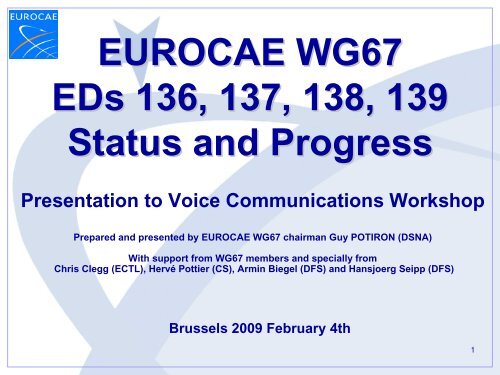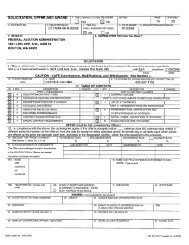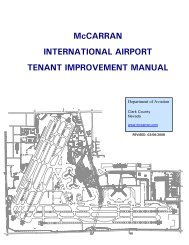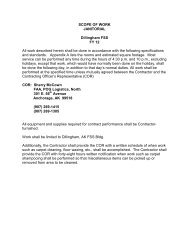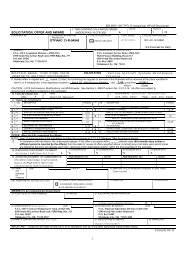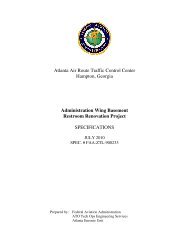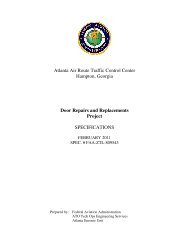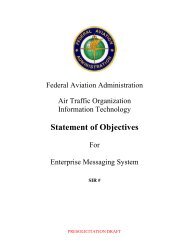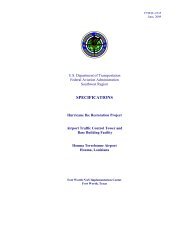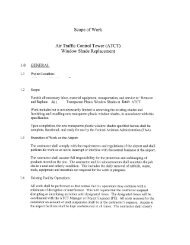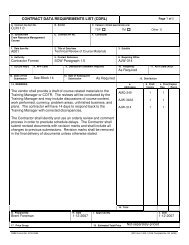EUROCAE WG67 EDs 136, 137, 138, 139 Status and Progress
EUROCAE WG67 EDs 136, 137, 138, 139 Status and Progress
EUROCAE WG67 EDs 136, 137, 138, 139 Status and Progress
Create successful ePaper yourself
Turn your PDF publications into a flip-book with our unique Google optimized e-Paper software.
<strong>EUROCAE</strong> <strong>WG67</strong><strong>EDs</strong> <strong>136</strong>, <strong>137</strong>, <strong>138</strong>, <strong>139</strong><strong>Status</strong> <strong>and</strong> <strong>Progress</strong>Presentation to Voice Communications WorkshopPrepared <strong>and</strong> presented by <strong>EUROCAE</strong> <strong>WG67</strong> chairman Guy POTIRON (DSNA)With support from <strong>WG67</strong> members <strong>and</strong> specially fromChris Clegg (ECTL), Hervé Pottier (CS), Armin Biegel (DFS) <strong>and</strong> Hansjoerg Seipp (DFS)Brussels 2009 February 4th1
Background <strong>and</strong> scope• Components of Ground-Ground ATM voice systems are currentlyusing digital (TDM/PCM - Time Division Multiplexing / Pulsed CodeModulation) or analogue technology• Convergence of voice <strong>and</strong> data into one multimedia network isobserved on the market.• Voice over IP Technology may fulfil <strong>and</strong> improve operational <strong>and</strong>technical ATM voice communication requirements,• Pan-European Network Services (PENS) will be offering IP Voicecommunications capability from 2010, for ATM purposes anytimeafterwards2
<strong>WG67</strong> works• Define IP Voice ATM Systems <strong>and</strong> identify their components(Voice Communication System / VCS, Telephone Ground-Ground communication, Ground based Radio Station /Recording, Supervision)• Four documents written by the different subgroups have been created to fullfillthe <strong>WG67</strong> objectives:– ED<strong>136</strong> (SG1): Voice over Internet Protocol (VoIP)Air Traffic Management (ATM) System Operational <strong>and</strong> Technical Requirements– ED<strong>137</strong> (SG2): Interoperability St<strong>and</strong>ards for VoIP ATM Components• Part 1: Radio• Part 2: Telephone• Part 3: Recording• Part 4: Supervision– ED<strong>138</strong> (SG3): Network Requirements <strong>and</strong> Performances for VoIP ATM Systems• Part 1: Network Specification• Part 2: Network Design Guideline– ED<strong>139</strong> (SG4): Qualification tests for VoIP ATM Components <strong>and</strong> Systems3
Bodies involved• European ANSPs : ACG, AENA, Belgocontrol, DFS, DSNA, ENAV, LVNL, NATS,ROMATSA• FAA• European ATM Suppliers: VCS <strong>and</strong> GRS• Telecom equipment suppliers: CISCO, NORTEL• Telecom Operators: SITA• RTCA <strong>and</strong> appropriate regulators <strong>and</strong> st<strong>and</strong>ardisation bodies (ICAO,Eurocontrol, ITU, ETSI …)• Liaison with military will be maintained by organisations such as Eurocontrol,Suppliers…• Results of WG 67 are anticipated to be presented to ICAO panel ANC forconsideration as international recommendations.• TORs approved on July 2004by <strong>EUROCAE</strong> Council4
Vienna AgreementDefine IP Voice ATM Systems <strong>and</strong> identify their components (VoiceCommunication System / VCS, Ground based Radio Station / GRS…)5
<strong>WG67</strong> deliverables• ED-<strong>136</strong> – Voice over IP ATM System Operational <strong>and</strong> Technical Requirementsto define <strong>and</strong> develop VoIP ATM System operational <strong>and</strong> technical requirements• ED-<strong>137</strong> - Interoperability St<strong>and</strong>ards for VoIP ATM Componentsto define first, IP st<strong>and</strong>ards to fulfil operational <strong>and</strong> technical requirements,secondly to develop IP interfaces between IP components as defined in “ViennaAgreement”• ED-<strong>138</strong> - Network Requirements <strong>and</strong> Performances for VoIP ATM Systemsto define <strong>and</strong> develop Network requirements <strong>and</strong> performances to fulfil QoSrequired to interconnect IP components• ED-<strong>139</strong> - Qualification tests for VoIP ATM Components <strong>and</strong> Systemsto define <strong>and</strong> develop validation requirements for VoIP ATM System <strong>and</strong>Components6
ED <strong>136</strong>, <strong>137</strong>, <strong>138</strong>DEVELOPMENT, APPROVAL & PLANNINGPROCESSWG : Final Draft 1:December 2006-March 2008Internal <strong>WG67</strong> consensus: Draft on web <strong>and</strong> sent toworldwide CAC (Civil Aviation Community)EnlargedConsultationMay 2008-July 2008WG Final Draft 2 taking inaccount comments from CACDecember 2008Request for comments (comments sheetfilled) from CAC: Analysis of all comments by<strong>WG67</strong> <strong>and</strong> draft amendment as required bySGsFinal Draft 2 <strong>and</strong> summary of commentanalysis to CouncilEurocae Council Approval:February 2009Publication:February 20097
ED-<strong>136</strong>Voice over IP ATM System Operational <strong>and</strong>Technical Requirements8
Requirements – Two Principle Subjects• Ground Telephone• Radio9
Ground TelephoneExample• Instantaneous Access (IA) Calls- established within 1 second or less for 99% ofcall attempts (ICAO Doc 9804 Table 1-1)- called party position monitoring10
RadioPossibly the first attempt at definitive Requirements?• First taskproduce baseline reference model of currentsystems• Second taskobtain performance data (actual & st<strong>and</strong>ards)11
Baseline Model - Scope•‘Basic’ air-ground radio•Multi-carrier (Climax)•Frequency Cross-Coupled•Best-signal selection (BSS)12
Signalling Requirement80 ms 20 ms100 ms50 ms 50 ms100 ms13
Voice Latency Requirement120 ms 10 ms130 ms105 ms 25 ms130 ms14
Radio – Special Notes• Requirements are the most stringent for Hi-DensityAirspace (<strong>and</strong> may be relaxed for other applications)• Now incorporated into the ECTL/FAA doc ‘CommsOperating Concept & Requirements (COCR) V2’15
ED <strong>137</strong>Interoperability St<strong>and</strong>ardsfor VoIP ATM Components16
•ED <strong>137</strong>-2•TelephoneED<strong>137</strong> specification domains•ED <strong>137</strong>-1•Radio•ED<strong>137</strong>-3•Recording17
ED <strong>137</strong>-1RADIO18
RADIO signalling principles• Session initialization based on SIP protocol (RFC 3261)– SIP allow to adress dynamically any radio– Call initiation is done through SIP mechanism. Voice is managedthrough RTP Extender.• Permanent monitoring of the session by using « keep alivemessage » between Ground radio equipment <strong>and</strong> VCS site• Audio protocol: Based on RTP/RTCP (RFC 3550).• Radio Control signalling using additional informations added inRTP protocol (RTP Extender field):– PTT, A/C– Audio quality index– Time stamp parameters for CLIMAX use– Reserved field for future or proprietary use• Proposed CODEC: G711 , <strong>and</strong> optional G728 or G72919
Radio to VCS Communication principles20
RTP Extender principlesEthernet/UDP PacketsEthernet/UDP Packets~Ethernet/IP~- PTT (8 possible values)- Reserved for future UseEthernet/UDP PacketsEthernet/UDP Packets~Ethernet/IP~Audio- A/C (Aircraft Call)- Reception quality index- CLIMAX Time stamp- PTT Control- Reserved for future or proprietary Use21
ED<strong>137</strong>-2TELEPHONE22
TELEPHONE signalling principles• Session initialization based on SIP protocol (RFC 3261)– SIP allow to adress dynamically any correspondent– Call initiation is done through SIP mechanism. Voice is managedthrough RTP Extender.• Audio protocol: Based on RTP/RTCP (RFC 3550).• Proposed CODEC: G711 , <strong>and</strong> optional G728 or G729• Signalling interworking between:– Eurocontrol ATS-R2 <strong>and</strong> SIP– ATS-R 5 <strong>and</strong> SIP– ATS-QSIG <strong>and</strong> SIP• Additional features as Priority Call, Instantaneous Call <strong>and</strong>Conference Call specified for existing <strong>and</strong> future VCScommunication architecture implementation.23
TELEPHONE Protocol StackApplication <strong>and</strong> System ControlInterworking functionSIP SuiteSupplementary Services(Intrusion, Instantaneous Access, Call hold, Conference…)RTCPAudiocodingfunctionsATS-R2ATS-No.5ATS-QSIGBasic SIP+ Extension headers+ Added Methods+ Message Body (SDP)RTPTCP/TLSUDPIPIP network lower layers24
TELEPHONE Interoperability• interoperability with existing VCS through IPnetwork– VCS SIP VCS– VCS SIP ATS-R2– VCS SIP ATS-R5– VCS SIP ATS-QSIGSIPVCSVCSSIPWANSIPATS R2InterfaceATS R5InterfaceVCSVCSATS QSIGinterfaceVCS25
ED<strong>137</strong>-3RECORDING26
• Today: recording is provided by the VCS.RECORDING• The ED<strong>137</strong>-3 document allow to make profit of the ETHERNET functionalities byspecifying the audio communication frame to a recorder.• Radio Recording is based on active sessions opened from clients (User Terminal,Radio Transmitter/Receiver or specific 3rd party devices) to one recording device• User Terminals participating a Telephone G/G communication session have toprovide a single audio stream that summarizes all incoming (IN) <strong>and</strong> outgoing (OUT)audio streams.27
RECORDING• Session initialization with recorder is based on SIP protocol (RFC 3261)• RTSP based on RFC 2326 is proposed to establish, terminate <strong>and</strong>modify recording sessions• Record data include the following information:– Voice– Telephone call identification– Radio channel identification– Time– Connecting <strong>and</strong> release time– Priority– Direction (Incoming-Outgoing)28
ED <strong>138</strong>Network Requirements <strong>and</strong>Performances for VoIP ATM Systems29
ED<strong>138</strong>The purpose of ED<strong>138</strong> is to specify the network requirements <strong>and</strong>the needs of VoIP network services for ATM applications - includingIP Adressing <strong>and</strong> Security - that are to provide the necessary highlevels of availability, integrity, performance <strong>and</strong> Quality of Service(QoS) for VoIP in ATM applications.ED-<strong>138</strong> is divided into two parts:• ED-<strong>138</strong> Part 1– Network Specification– Security Policy– IP Addressing Plan• ED-<strong>138</strong> Part 2– Network Design Guideline30
IP SecurityTechnical Security Policy• Required security architecture <strong>and</strong> component mechanisms• Different security zones are defined with different requirementsSecurityZone 1SecurityZone 2Responsibility ofIP Core ProviderIP CoreEdgeIP CoreIP CoreEdgeIP CoreEdgeIP Core couldbe PENSPossible InterconnectionsSecurityZone 3Responsibility ofANSPs/OrganizationsOrganizationEdgeOrganization(WAN)LANOrganizationEdgeOrganization(WAN)LANOrganizationEdgeOrganization(WAN)LANAdminNetwor32
IP Addressing SchemeIP AddressingPAX• Totally based on TF * results.• Usage of IPv6 is m<strong>and</strong>atory for full interworkingRIPE Responsibilty(32 bits)3 13 13 3 3 13 16 64FP TLA ID Sub-TLA Res. NLA ID SLA ID Interface IDF1Net.Prefixv4/v6F2SiteLocationLANESI3 bits7 bits1 bit5 bitsvariable bitsvariable bits64 bitsCommon Responsibilty(Coordination Body)(16 bits)ANSP Authority(80 bits)The IPv6 addressing scheme is regularly presented to the EUROCONTROL EATM Communication Team33* EUROCONTROL EATM Internet Protocol for Aeronautical Exchange Task Force
Network Design Guideline• The purpose of ED<strong>138</strong> Part 2 is to give solutions <strong>and</strong> guidelines to fulfill therequirements.• The document also supports to underst<strong>and</strong> existing st<strong>and</strong>ards• More than 200 pages give a comprehensive overview about VoIP architecture,protocols <strong>and</strong> network designs.Simple tasksscheduling.Complex tasksmarkingrEdge router:• Traffic Classification• Policing• ShapingCore router:DSCP Data• Buffering <strong>and</strong> Scheduling based on marking at edge• Assured Forwardingb34
ED <strong>139</strong>Qualification tests for VoIP ATMComponents <strong>and</strong> Systemsto be published mid 200935
ED <strong>139</strong> target:how to validate components <strong>and</strong> interfaces36
A Step by Step ValidationNetwork levelValidation progressEquipmentlevelSystemlevelInterface level37
Test validation definitionPassED <strong>136</strong>-RequirementsEnvironmentED <strong>137</strong>-SpecificationsTestcases&ProceduresValidationGuidelinesDeviceundertestED <strong>138</strong>-SpecificationsFail38
H<strong>and</strong>s on (interoperability test)<strong>and</strong> forecast• 1st Plugtests in March 2008 (stage 1)http://www.etsi.org/WebSite/News<strong>and</strong>Events/2008_04_<strong>EUROCAE</strong>.aspx• 2nd Plugtest in March 2009 (stage 1 <strong>and</strong>2)http://www.etsi.org/plugtests/eurocae2/eurocae.htm• VoIP- R2 & ATS-QSIG Gateway Test inautumn 200939
<strong>EDs</strong> STATUS (February 2009)• three documents with a common reference to« Vienna Agreement » are published by<strong>EUROCAE</strong> for utilization within VoIP ATMSystem:– ED-<strong>136</strong> - Voice ATM System Operational <strong>and</strong>Technical Requirements– ED-<strong>137</strong> - Interoperability St<strong>and</strong>ards for VoIPATM Components– ED-<strong>138</strong> - Network Requirements <strong>and</strong>Performances for VoIP ATM Systems• ED-<strong>139</strong> - Qualification tests for VoIP ATMComponents <strong>and</strong> Systems should bepublished mid 200940
Actions to go further toImplementation phase• ED <strong>136</strong>, <strong>137</strong>, <strong>138</strong> validation through ETSIPlugtests <strong>and</strong> SESAR Projects with supportof ED <strong>139</strong>• Define <strong>and</strong> developp VoIP ESSI from ED <strong>136</strong>,<strong>137</strong> <strong>and</strong> <strong>138</strong>• To include ED <strong>136</strong>, <strong>137</strong>, <strong>138</strong> within ICAOSARPS for GG Voice (including GG segmentfor AG communication)• To start validation of ATM VOIP over PENSfrom 201041
ATM VoIP st<strong>and</strong>ardisationa necessary Role for each Body• Every European Organization was <strong>and</strong> is needed:– <strong>EUROCAE</strong> mixing closely <strong>and</strong> friendly in the same forum (WG, SGs,Review Team) all stakeholders:• Users expressing operational requirements <strong>and</strong> validating technicalsolutions proposed by Industry• Industry proposing technical solutions fulfilling operational requirements<strong>and</strong> limiting over-specified requirements from users– ETSI allowing, thanks technical (IP) skills <strong>and</strong> neutral arbitration furingshort Interoperability Plugtests, to accelerate maturation of draftst<strong>and</strong>ards : very good efficiency/cost ratio– SJU <strong>and</strong> EUROCONTROL st<strong>and</strong>ard validation– EUROCONTROL preparation of global ICAO st<strong>and</strong>ardization, EuropeanSingle Sky Implementation (ESSI) objective definition <strong>and</strong> follow-up– EU/EC for European legal framework : IR?, CS?, ..Conclusion: Cooperation is needed between all these Bodies42
Thank you for your attention<strong>EUROCAE</strong>The European Organisation for Civil Aviation Equipment102, rue Etienne Dolet 92240-Malakoff (France)Phone: +33 1 40 92 79 30Web site: www.eurocae.eu43


